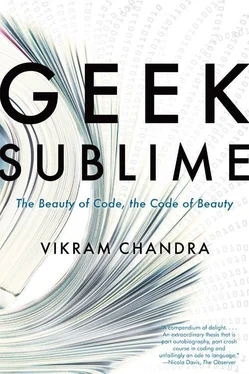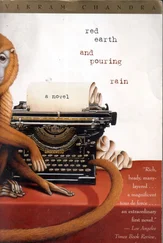III. The Universe is the interior of the Light Cone of the Creation.
IV. Science is a Differential Equation. Religion is a Boundary Condition.
And on the third postcard, Turing writes:
V. Hyperboloids of wondrous Light
Rolling for aye through Space and Time
Harbour there Waves which somehow Might
Play out God’s holy pantomime.
22

Red Earth and Pouring Rain was published in 1995. It feels now, of course, like it was written by somebody else, by another person with whom I am moderately familiar. When I try to recall its writing, what I remember is the heat haze of Houston afternoons; reading photocopied historical texts in a transit lounge at Dubai airport; moments of uncertainty and thirty-something unpublished-writer panic in Bombay when I ran into school friends who already had jobs, spouses, children, homes. I remember girlfriends, and loneliness, and the generosity of my teachers. And vividly, I remember computers, the machines I spent endless hours with, through which my characters came alive: the borrowed IBM PCjr I began writing the book on, with its abominable Chiclet keyboard and associated stack of WordStar floppies; my clone XT, the first computer I ever owned, bought with the entirety of a grant that was supposed to supplement my meager TA stipend through a semester; “Sikander,” the big beast of a 486 clone I indulged in once I was making money as a consultant and programmer.
Makers tend to fetishize tools that they use successfully, and computer geeks are no exception — hackers will tell you in exacting detail about the first computer they ever used, the first program they ever wrote. My writing life and my life with computers, in spite of their differences, seem mirrored, twinned. Both are explorations of process, of the unfolding of connections. Both reward curiosity, dogged patience. And perhaps it is just the double presence that I cherish, of art and logic, of deep historical roots and newness. All cognition is re-cognition, recognition; discovery and rediscovery are both nourishing. It has been pointed out to me that my fiction proliferates doubles, couplings, alter egos, layers within layers. Duchamp noticed that “most artists only repeat themselves.” 23If so, an obsession with contradiction, paradox, ambiguity, and mirroring has been my repetition, one that I’m happy with. Repetition need not only be a grim karmic necessity, or an endless rehearsal of trauma. In the practice of fiction, what is tasted — first and then again — is consciousness itself.
Chapter 1: Hello, World!
1. Graham, “Hackers and Painters.”
2. Ibid.
3. Ibid.
4. Lampson, “Guest Editorial,” 195.
5. Ibid., 196.
6. Wright and Daintith, A Dictionary of Computing , 205.
7. Knuth, “Literate Programming,” 99.
8. Ibid.
9. Mataes and Montford, “A Box, Darkly,” 145.
10. Ibid., 194.
11. “The IBM 650 Magnetic Drum Calculator”; Mataes and Montford, “A Box, Darkly,” 194.
12. Oram and Wilson, Beautiful Code , loc. 482.
13. Ibid., loc. 473.
14. Mataes and Montford, “A Box, Darkly,” 145.
15. Ceglowski, “Dabblers and Blowhards.”
16. Graham, “Design and Research.”
17. Graham, “Hackers and Painters.”
18. Ceglowski, “Dabblers and Blowhards.”
19. Ibid.
Chapter 2: Learning to Write
1. Simon, Spies and Holy Wars , 98.
2. Jcoll [pseud.], “For Most of You, This Is Surely Child Play, but Holy Shit, This Must Be What It Feels Like to Do Heroin for the First Time.”
Chapter 3: The Language of Logic
1. Rob P., “How Do Computers Work?”
2. Jong89 [pseud.], “Razorlength—1036 Early Winter by Jong89.”
3. “Computer Scientists Build Computer Using Swarms of Crabs.”
4. Petzold, Code , 101–02.
5. See Gleick, The Information , loc. 2056–69.
6. Rob P., “How Do Computers Work?”
7. Ganssle, “Microprocessors Change the World.”
8. Winegrad and Akera, “A Short History of the Second American Revolution.”
9. Ganssle, “Microprocessors Change the World.”
Chapter 4: Histories and Mythologies
1. Rosenberg, Dreaming in Code , 300–01.
2. Nather, “The Story of Mel.”
3. Ibid.
4. Ibid.
5. Ibid.
6. Used with permission from Microsoft. Lippert, “Cargo Cultists, Part Three: Is Mort a Cargo Cultist?”
7. Ibid.
8. Ibid.
9. Ibid.
10. Ibid.
11. Nather, “The Story of Mel.”
12. Ibid.
13. Wozniak, “And Then There Was Apple.”
14. Livingston, Founders at Work , 45.
15. Ibid., 49.
16. DFectuoso [pseud.], “Solo Development — Are There Any Famous One-Man-Army Programmers?”
17. “Programming the ENIAC.”
18. Ensmenger, The Computer Boys Take Over , 14–15.
19. Ibid., 37.
20. Ibid., 39.
21. Ibid., 74.
22. Ibid., 238.
23. Ibid., 16.
24. Ibid., 69.
25. Ibid., 79.
26. Ibid., 137.
27. Ibid., 144.
28. Ibid., 231.
29. Ibid., 168.
30. Ibid., 239–40.
31. Griffin, “The Place of the Bengali in Politics,” 812.
32. Ibid., 813.
33. Barrett, “Why We Don’t Hire.NET Programmers.”
34. Ibid.
35. Ibid.
36. Solnit, “Diary.”
37. Ibid.
38. See Lacy, “And You Thought SF Cabs Were Bad? BART Strike Is Crippling Fledgling Mid-Market Tech Corridor.”
39. Silver, “In Silicon Valley, Technology Talent Gap Threatens G.O.P. Campaigns.”
40. Barbrook and Cameron, “The Californian Ideology,” 44.
41. Ibid., 55.
42. Matyszczyk, “Woz: Microsoft Might Be More Creative Than Apple.”
43. Torvalds, “Re: Stable Linux 2.6.25.10”; Leonard, “Let My Software Go!”; Raymond, “Microsoft Tries to Recruit Me.”
44. Bailey, “Dear Open Source Project Leader: Quit Being a Jerk.”
45. Alec Scott, e-mail to author, November 29, 2012.
46. Brockmeier, “How Casual Sexism Put Sqoot in the Hotseat.”
47. Bassett, “Aligning India in the Cold War Era,” 786.
48. Bassett, “MIT-Trained Swadeshis,” 215.
49. Ibid., 213.
50. Ibid., 215.
51. Ibid., 225.
52. Ibid., 227.
53. Ibid.
54. Ibid., 229–30.
55. Bassett, “Aligning India in the Cold War Era,” 783.
56. Ibid., 791.
57. “Immigrant Entrepreneurship Has Stalled for the First Time in Decades, Kauffman Foundation Study Shows.”
58. Khan, “40 % of Startups in Silicon Valley Are Headed by India-Based Entrepreneurs.”
59. Stahl, “Imported from India.”
60. Sivakumar, Dude, Did I Steal Your Job? , 33.
61. Mukherji, “Student Suicides Soar 26 % in 5 Years, Education System Blamed.”
62. Spectre, “Twilio’s Definitive Brogramming Primer.”
63. MacMillan, “The Rise of the ‘Brogrammer.’”
64. Scott, “Lessons from Canada’s Silicon Valley Diaspora.”
65. World Economic Forum, Global Gender Gap Report.
66. “We believe that currently in most IT companies (IBM India, Accenture India, Infosys, Wipro, TCS, HCL, Cognizant, iGate, etc.), the percentage of women is also 30 % at the lower level …” Alok Aggarwal (co-founder and chairman, Evalueserve), e-mail to author, December 8, 2012; “Household Data Annual Averages: Employed Persons by Detailed Occupation, Sex, Race, and Hispanic or Latino Ethnicity.”
67. Varma, “Exposure, Training, and Environment,” 205; DuBow, “NCWIT Scorecard: A Report on the Status of Women in Information Technology.”
Читать дальше













